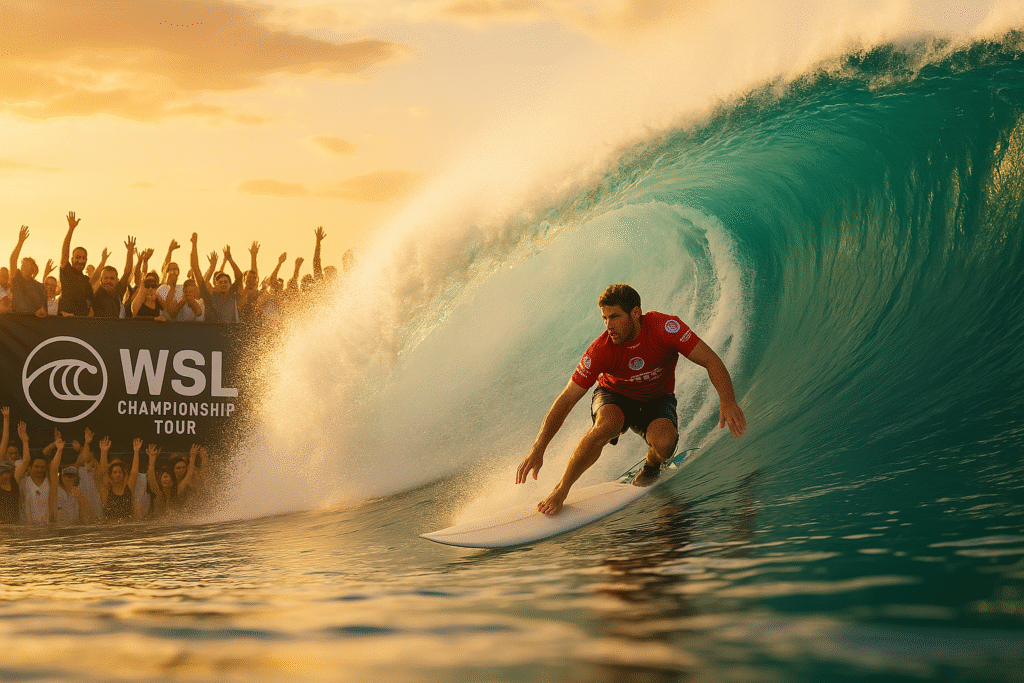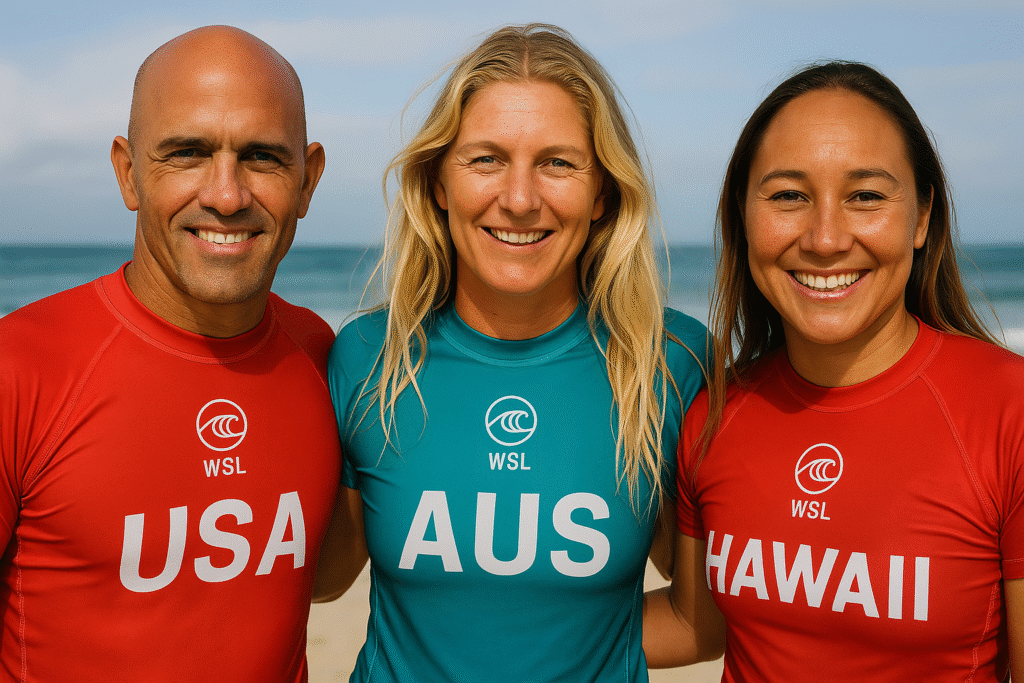Surfing: Introduction and Cultural Significance – Surfing is a sport with ancient Polynesian roots. Captain James Cook in 1788 observed Tahitians and Hawaiians riding long wooden boards on waves, and American author Mark Twain wrote about Hawaiian surfing in 1871. By the 1920s–30s, California had become a hotbed of the sport, and surfing exploded into mainstream culture by the 1950s. Its appeal lies in sheer simplicity and excitement: one simply paddles on a board and rides a wave’s energy toward shore. In fact, as the encyclopedia World of Sports Science notes, “Surfing has attained a worldwide appeal due in large part to its utter simplicity”. This accessibility – combined with the adrenaline rush and connection to nature – helped spawn a distinctive surf culture. By the 1960s, beach movies (“Gidget,” Ride the Wild Surf), surf music (Dick Dale’s “Misirlou,” the Chantays’ “Pipeline”), and surfer slang (“stoked,” “wipeout,” “surfari” travel) all spread the Hawaiian/California vibe worldwideencyclopedia.com. Today, Surfing is both a competitive sport and a lifestyle symbol, with surfers prizing both athletic achievement and a free-spirited “soul-surfing” ethos.
Surfing: Basic Rules and Equipment
In Surfing, riders follow informal priority rules in the lineup. In the water, “the surfer closest to the peak of the breaking wave” has right of waydelmar.ca.us. Cutting in front of that surfer – known as a “drop-in” – is considered very poor etiquettedelmar.ca.us. Other courtesy rules include waiting your turn (“first to feet” rule) and not paddling into someone riding a wave.
Key equipment for Surfing includes the board and related gear. Soft-top longboards (often 8–9 feet long) are recommended for beginners because their extra volume makes paddling and catching waves easierbodhisurfyoga.com. Modern boards use lightweight synthetics – epoxy, fiberglass, carbon fiber – in place of old heavy wood. A surfboard’s fins (“skegs”) at the tail stabilize the board, acting like a boat’s keel to prevent the board from sliding sideways. Surfers attach a leash to their ankle (or calf) so the board can’t drift away; this basic gear (plus wax for grip) is essentialbodhisurfyoga.comdelmar.ca.us. In cold water (below about 68°F/20°C) a neoprene wetsuit or protective rashguard is worn to stay warmdelmar.ca.us.
Professional Surfing contests have their own rules. Competitors surf in timed heats (typically 20–30 minutes) and try to catch waves for scoring. A panel of judges scores each ride on a 1–10 scale and averages scores (dropping the highest and lowest)worldsurfleague.com. The surfer’s two best waves are combined for the heat total. Judges look at factors like commitment (wave size), degree of difficulty, innovative maneuvers, speed, power and flowworldsurfleague.com. Thus, the surfer riding a very big, radical wave with well-executed turns will score higher than one on a small or sloppy wave.
Surfing: Major Events and Competitions

Today’s world features a global calendar of events. The World Surf League (WSL) Championship Tour is the premier professional circuit for men and women. Top-ranked surfers compete in about a dozen events each year (from Australia to Brazil to Hawaii), earning points toward the world title. For example, in 2024 the WSL crowned John John Florence (Hawaii) as men’s world champion and Caitlin Simmers (USA) as women’s world championworldsurfleague.comworldsurfleague.com. The WSL tour was formerly known as the ASP (Association of Surfing Professionals) until 2015encyclopedia.comworldsurfleague.com.
In addition to the pro tour, international federation events are important. The International Surfing Association (ISA) – the sport’s world governing body – stages annual championships. The ISA World Surfing Games, for instance, is a team-based “world cup” where surfers compete for national pride. In 2024, Brazil’s team (led by champion Gabriel Medina) won the ISA World Games, securing a third men’s Olympic qualifying spot for Brazilnbcolympics.com. Other ISA events include the World Junior Surfing Championship and World Longboard Championship.
It has also become an Olympic sport. The 2020 Summer Olympics in Tokyo (held in 2021) marked Surfing’s Olympic debut with 20 men and 20 women competing on the waves of Chōshi, Japanen.wikipedia.org. (Brazil’s Ítalo Ferreira won the first men’s Olympic gold, and Hawaii-born Carissa Moore the first women’s gold.)It will again feature at Paris 2024. Beyond the WSL and Olympics, notable standalone contests – such as the Big Wave Tour events at Mavericks or Nazaré – draw elite big-wave riders.
Surfing: Famous Surfers and Champions

The legend of this Sports is tied to its champions. Kelly Slater (USA) is widely considered the greatest surfer ever; he has won an unprecedented 11 world titles (including five consecutively from 1994–98)britannica.com. Stephanie Gilmore (AUS) dominated the women’s side with eight world championships (2007–10, 2012, 2014, 2018, 2022)en.wikipedia.org. Carissa Moore (USA/Hawaii) is another icon – a five-time women’s world champion and the first Olympic gold medalist in women’s surfing (Tokyo 2020)en.wikipedia.org. Ítalo Ferreira (BRA) won the men’s WSL title in 2019 and earned the first men’s Olympic gold in Tokyoen.wikipedia.org. Other notable stars include Gabriel Medina (BRA), a three-time world championnbcolympics.com, and John John Florence (HAW), the 2024 men’s champion and two-time titlist (2016, 2017)worldsurfleague.com. The success of these elite athletes has made them household names among fans and inspired new generations of surfers worldwide.
Surfing: Historical Evolution and Cultural Impact
Surfing evolved from ancient roots to a modern sport. It’s roots in Polynesian culture gave way to modern boards in the 20th century. The first recorded surf championships took place at Makaha, Hawaii in 1953 – an event that the Hawaiian Surfing Association called the “official birth of the sport”encyclopedia.com. (Interestingly, many surfers at the time shunned competition, preferring the free-spirited “surfari” lifestyleencyclopedia.com.) In 1976 a coalition of Hawaiian and Australian surfers formed the ASP (now WSL) to organize professional competitions and attract sponsorsencyclopedia.com. That decade marked a turning point: the “shortboard revolution” had already shrunk board lengths from 10+ feet down to about 8 feet, making it more radical and performance-oriented (noted in surf history texts). Meanwhile, surf culture continued influencing music, fashion and film around the world. By integrating this sport into mainstream sports structures, the community balanced its countercultural image with professional athleticismencyclopedia.com. Today’s surfers still honor that history – riding modern equipment while celebrating the Hawaiian and ’60s California heritage.
Surfing: Cups and Their Significance
It’s competitions sometimes use “cup” nomenclature, reflecting tradition. For example, Hawaii’s annual Vans Triple Crown series famously includes an event called the World Cup of Surfing at Sunset Beachen.wikipedia.org. This is a prestige big-wave event on the North Shore calendar. The term “world cup” also applies to ISA team championships: the ISA World Surfing Games is essentially a surfing world cup where national teams compete. (As noted, winning the World cup one can earn Olympic qualification spotsnbcolympics.com.) While the Olympics award medals rather than a cup, the Olympic surfing competition is often colloquially thought of as the sport’s “ultimate prize.” In short, “cups” – whether in event names or trophies – signify titles of high honor in the sport’s community.
Surfing: Innovations and Developments
Technological progress continues to shape Surfing. Modern boards, for instance, use advanced composite materials (foam cores, epoxy resins, carbon fiber laminates). These make boards lighter, stronger and more maneuverable than old wooden designs. Safety gear has also evolved: the inflatable life jacket (introduced in 2011) can be deployed during a big-wave wipeout to rapidly bring a surfer to the surfacetheinertia.com. Likewise, the adoption of personal watercraft (jet skis) for tow-in surfing in the 1990s revolutionized big-wave riding – enabling surfers to catch far larger waves and allowing rapid rescue if neededtheinertia.com. In recent years, artificial wave pools (like Kelly Slater’s Surf Ranch and commercial Surf Lakes/Wavegarden systems) have created perfect waves on demand, revolutionizing training and competition venues. On the competitive side, this sport has also embraced data and broadcasting tech: live judging replays, surf-forecast analytics, and underwater cameras all help athletes and fans alike. Overall, each innovation – from board design to safety equipment – has pushed this Sport into new realms, increasing performance and making the sport more accessible and exciting.
You can also read about Golf
Sources: Authoritative surf histories and organizational reports (International Surfing Association, World Surf League, Olympic archives, etc.) provide details on the points aboveworldsurfleague.comworldsurfleague.combritannica.comen.wikipedia.org.
